I can’t help but adore chrysanthemum flowers – they’re burst of happiness and colors in any bouquet.
What’s even better? Chrysanthemum tea!
It’s a whole new world of floral delight.
Once you’ve tasted homemade chrysanthemum tea, there’s no turning back.
Trust me, I’ve been there.
Those store-bought ones just can’t compete.
Why? Well, it’s because homemade chrysanthemum tea is not only yummier but also healthier.
The fragrance of dried chrysanthemum petals is like a little piece of heaven!
So, if you haven’t tried it yet, you’re in for a treat.
Chrysanthemum flowers, with their array of colors, are just the beginning.
When steeped the right way, they make a tea that’s simple, fragrant, and oh-so-refreshing.
Give it a go, and you’ll fall in love – just like I did.
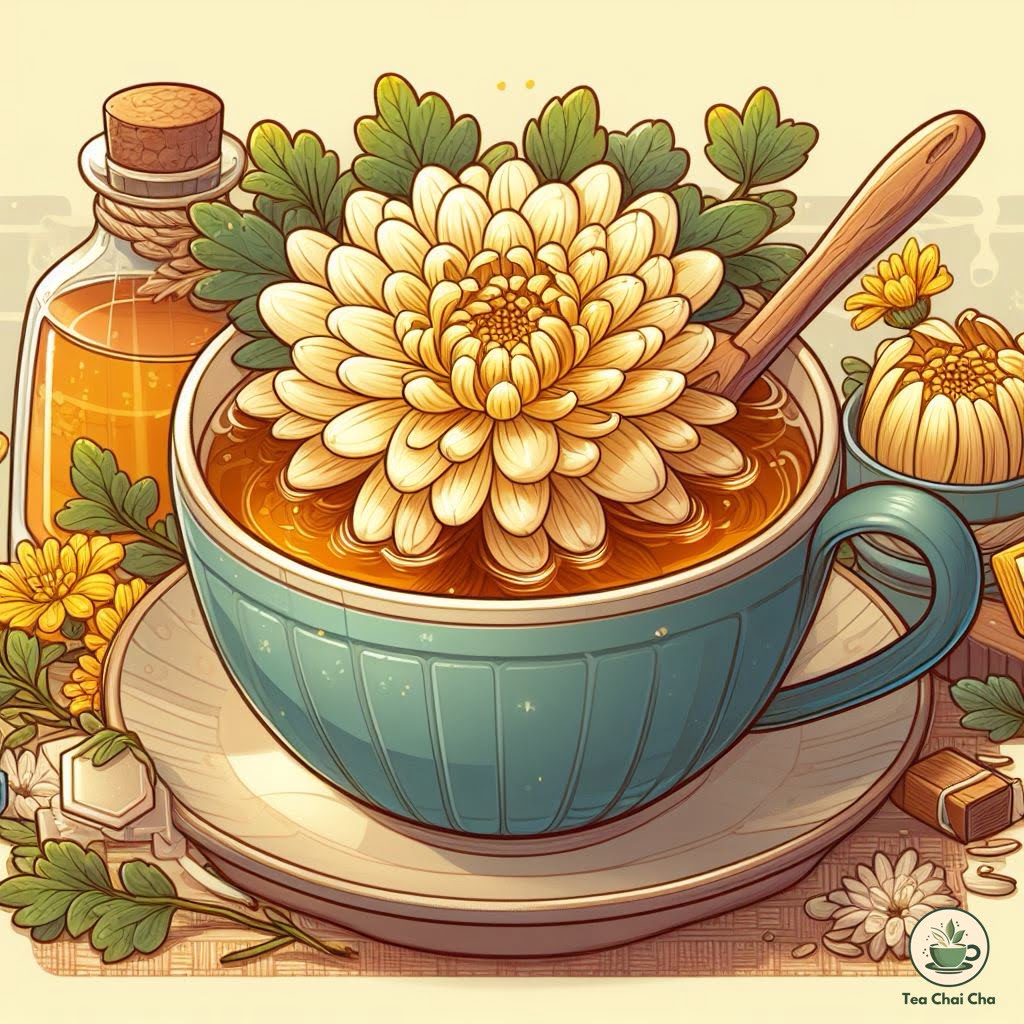
What Is Chrysanthemum? (菊花, KIKU)
Chrysanthemums, or “mums” for short, are these lovely flowers that you can’t help but admire.
Their scientific name is Chrysanthemum indicum, and they have a fascinating history and use in various parts of the world.
These vibrant beauties originally hail from East Asia, with China being their homeland.
You might be surprised to learn that they have different names in different countries.
In China, chrysanthemums are called “菊花” (jú huā.)
In Japan, they’re called “KIKU,” and they hold a special place in their culture, even appearing on their Imperial Seal.
In some places, they’re known as “mums” or “chrysanths” for short.
When it comes to types, chrysanthemums are like a rainbow.
There are so many varieties with different shapes and colors.
You’ll find them in cheerful yellows, pinks, whites, and even some funky two-toned varieties.
As for uses, chrysanthemums aren’t just for looking pretty.
They’ve been used for centuries in traditional medicine, especially in China.
People make tea from their dried petals, which is believed to have various health benefits.
They’re also a popular choice for floral arrangements and as a symbol of joy and optimism.
Chrysanthemums have a rich history, dating back to ancient China over 2,500 years ago.
Emperors admired them, and poets wrote about their beauty.
They eventually made their way to Europe, where they gained popularity in the 17th century.

What Is Chrysanthemum Tea?
Chrysanthemum tea, or as some call it, “guk fa cha,” is a warm herbal tea.
It’s a delightful drink made from those lovely chrysanthemum flowers we talked about earlier.
When you steep these dried chrysanthemum petals in hot water, something magical happens.
You get this fragrant, aromatic infusion that’s both soothing and refreshing.
What makes it even more awesome is that it’s not just delicious; it’s good for you too.
Chrysanthemum tea is believed to have some health benefits, like calming your nerves and helping with digestion.
5 Chrysanthemum Tea Benefits
When I’m not feeling my best, there’s one trusty companion I turn to: chrysanthemum tea.
It’s my secret weapon against all sorts of woes.
This tea isn’t just delicious; it’s a health superstar too.
1. Fight Inflammation
Inflammation can be a real troublemaker in your life, causing everything from minor annoyances to major setbacks.
But chrysanthemum tea comes to the rescue.
It’s believed to have anti-inflammatory properties, which is a scientific way of saying it helps calm things down inside.
2. Rich in Vitamins
You won’t find me popping pills for vitamins when I have chrysanthemum tea on hand.
It’s loaded with vitamins A and C, the dynamic duo of immune support.
It’s a natural vitamin boost in every sip.
3. Lower Cholesterol
A study suggests chrysanthemum has flavonoids that can reduce the levels of cholesterol in your body.
For this reason, chrysanthemum can also help you weight reduction or management.
4. Balancing Act
According to Chinese medicine, our bodies can get a bit too “hot” sometimes, and that’s not a good thing.
This internal “overheating” can lead to all sorts of issues, from dry mouth to skin troubles.
Guess what cools things down nicely?
You guessed it, chrysanthemum tea.
5. Chinese Cool-Down
In China, chrysanthemum tea is a big deal.
It’s not just a health drink; it’s a way of life.
People from all walks of life swear by it.
You’ll see it in the hands of young professionals at their desks, in the cupholders of taxi drivers, and even carried around by wise old grandmas.
It’s a cooling and calming drink that’s stood the test of time.
Chrysanthemum Tea Side Effects
While I absolutely adore chrysanthemum tea for its taste and potential health benefits, it’s crucial to be aware of some possible side effects that can come with it.
Here’s what you need to know:
1. Skin Irritation & Sun Sensitivity
Sometimes, chrysanthemum tea might not agree with your skin.
It has the potential to trigger a skin condition called Contact Dermatitis.
This can lead to skin redness, rashes, and hives.
Plus, it can make your skin more sensitive to the sun, which isn’t ideal for those with easily irritated skin.
2. Allergic Reactions
Chrysanthemum tea isn’t for everyone, especially if you have a history of allergies.
If you’re allergic to things like dandelions, sunflowers, or various flower pollens, you might experience allergic reactions to chrysanthemum tea.
Keep an eye out for signs like redness, rashes, hives, or difficulty breathing.
If you’ve had such reactions before, it’s probably best to skip this tea.
3. Potential for Low Blood Pressure
Now, here’s something to note if you already have low blood pressure or are on medications to regulate it.
Chrysanthemum tea is known for its calming effect, and one way it achieves this is by lowering your blood pressure.
If your blood pressure drops too much, it can result in nausea, dizziness, and other discomforts.
So, if low blood pressure is something you deal with, you might want to think twice before sipping on chrysanthemum tea.

What You Need to Make Homemade Chrysanthemum Tea
So, you’ve decided to make your very own chrysanthemum tea, just like I did.
Great choice!
It’s a rewarding experience, and you’ll love the results.
But first things first, let’s gather what we need.
Chrysanthemum Tea Ingredients
Here are the star players for your homemade chrysanthemum tea:
1. Chrysanthemum Petals
The heart and soul of your tea, chrysanthemum petals (fresh, dried) are essential.
You can find them at specialty tea shops or online.
They come in various grades and qualities, so pick the best you can find for that heavenly fragrance and flavor.
2. Water
Make sure you use fresh, clean water.
It’s the canvas on which your chrysanthemum petals will paint their magic.
3. Optional Sweetener
If you like your tea a tad sweet, you can add some honey or sugar.
Equipment
Now, let’s talk about the tools of the trade, which are surprisingly simple:
1. Teapot or Tea Infuser
You’ll need something to steep those petals in.
A teapot with a built-in infuser is ideal, but a regular teapot or even a tea infuser ball works just fine.
2. Teacup
You’ll be savoring your creation in a teacup, so make sure it’s clean and ready for action.
3. Kettle or Pot
To heat up that water, you’ll need a kettle or a pot.
Nothing fancy, just something to get that water bubbling.
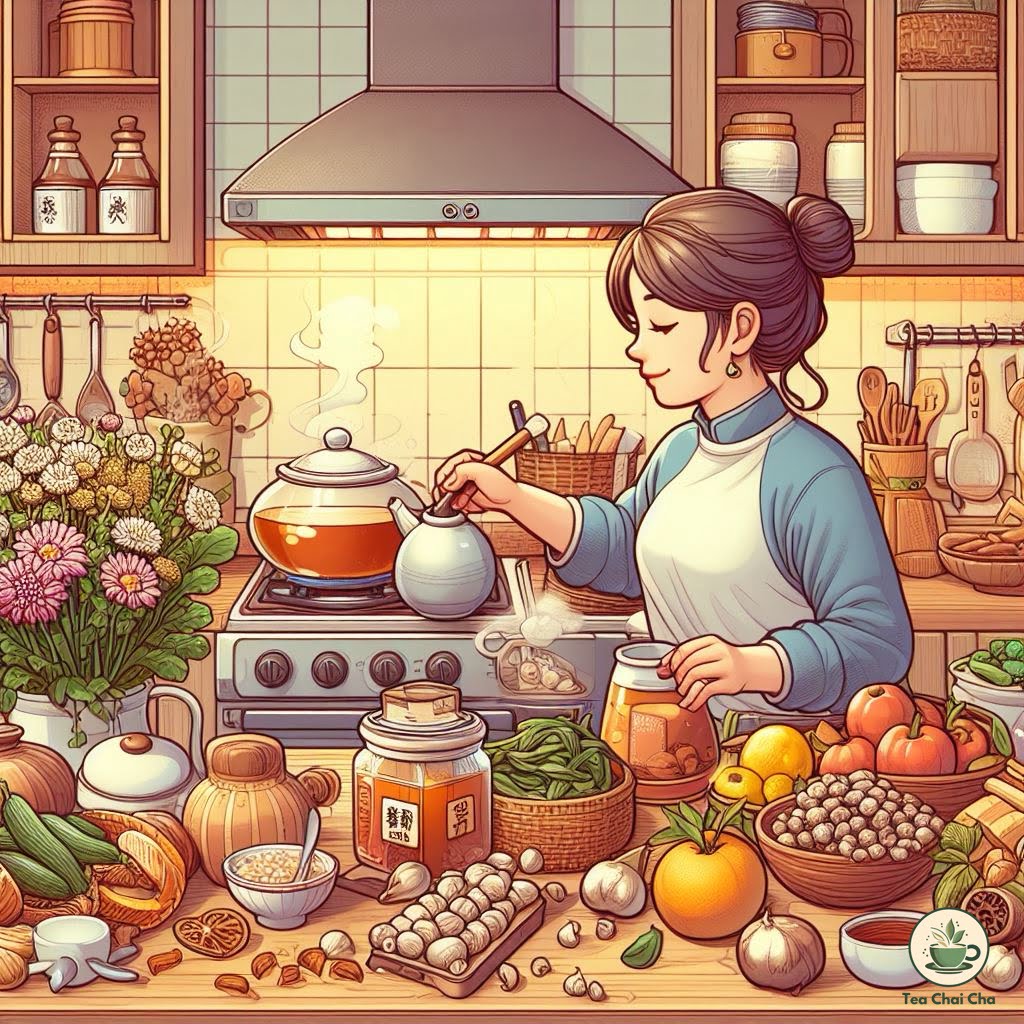
How to Make Chrysanthemum Tea from Fresh Flowers
The joy of crafting your own chrysanthemum tea from fresh flowers is different!
There’s something truly special about plucking those vibrant petals and turning them into a soothing, fragrant brew.
Let me guide you through the steps to create your own cup of floral delight.
Step 1: Gather Your Ingredients
For a single serving of chrysanthemum tea, you’ll need:
- 8 to 10 fresh chrysanthemum flowers (with petals intact)
- 1 cup of hot water
That’s it!
Just two simple ingredients to kickstart your chrysanthemum tea adventure.
Now, let’s move on to the exciting part – crafting your tea.
Step 2: Preparing the Fresh Chrysanthemum Flowers
Take your fresh chrysanthemum flowers and give them a gentle rinse under cold water.
This ensures that any dust or impurities are washed away.
Pat them dry with a clean kitchen towel.
Step 3: Steeping the Chrysanthemum Tea
Place the clean chrysanthemum flowers into a teapot or a heatproof glass.
Heat up your water until it’s nice and hot but not boiling. Around 190-205°F (87-96°C) is ideal.
Carefully pour the hot water over the chrysanthemum flowers in the teapot or glass.
Step 4: Let It Infuse
Cover the teapot or glass with a lid or saucer to trap the lovely aroma.
Let the chrysanthemum flowers steep in the hot water for about 5-7 minutes.
This allows the flavors to meld and create that delightful tea.
Step 5: Savor Your Homemade Chrysanthemum Tea
Once it’s done steeping, strain the tea into your favorite cup or mug, leaving behind the chrysanthemum flowers.
You can enjoy your chrysanthemum tea just as it is, or you can add a touch of honey or a slice of lemon if you prefer a sweeter or tangier note.
Scroll to the bottom to have complete recipe with ingredients and instructions.
How to Make Chrysanthemum Tea from Dried Flowers
No fresh chrysanthemum flowers? No worries!
You can use dried chrysanthemum flowers to make this soothing tea.
Here’s how I brew it:
Step 1: Gather Your Ingredients
For one serving of this delightful chrysanthemum tea, here’s what you’ll need:
Ingredients
- 1-2 teaspoons dried chrysanthemum flowers
- 1 cup of hot water
- Honey or sugar (optional, for sweetness)
Now, let’s move on to the next steps and brew this floral goodness.
Step 2: Preparing the Dried Chrysanthemum Flowers
Start by taking those beautiful dried chrysanthemum flowers and giving them a gentle shake to remove any dust or debris.
You want them to be clean and pristine for your tea.
Step 3: Boiling Water
Heat one cup of water until it’s hot but not boiling.
You can use a kettle or heat it on the stovetop.
Remember, you want to preserve the delicate flavors of the chrysanthemum flowers, so avoid using boiling water.
Step 4: Steeping the Chrysanthemum Flowers
Place the dried chrysanthemum flowers in your teapot or a cup.
You can use tea infuser ball if you have one.
Pour the hot water over them.
Cover the teapot or cup and let it steep for about 5-7 minutes.
Step 5: Sweeten to Taste (Optional)
If you have a sweet tooth, this is the time to add a teaspoon of honey or sugar to your tea.
Stir until it dissolves, and you’ll have a slightly sweeter version of chrysanthemum tea.
Step 6: Sip and Enjoy
Now comes the best part.
Grab your cup of homemade chrysanthemum tea, take a gentle sip, and savor the delicate floral notes.
Feel the worries of the day melt away with each sip.

Chrysanthemum Tea Hot or Cold?
So, when it comes to chrysanthemum tea, the Chinese have this fantastic tradition.
It’s like a versatile friend – you can enjoy it both hot and cold, depending on your mood and the weather.
When the chill of winter settles in, there’s nothing quite like a steaming cup of hot chrysanthemum tea.
It warms you up from the inside out, and the soothing aroma can be a perfect companion during those cozy moments by the fireplace.
But as the days grow warmer, the Chinese often switch to iced chrysanthemum tea.
It’s a natural cooler for those scorching summer days.
Just imagine a glass filled with ice cubes clinking together, and the refreshing, floral notes of chrysanthemum dancing on your taste buds.
It’s pure bliss, for sure!
In fact, chrysanthemum tea is often associated with health benefits, especially in Chinese traditional medicine.
They believe (as I mentioned it earlier) that cold chrysanthemum tea can help expel heat and toxins from the body, making it a popular choice during hot weather.
How to Make Iced Chrysanthemum Tea
Want to try the iced version of chrysanthemum tea? I got you!
Follow this recipe to brew iced/cold brew chrysanthemum tea:
Ingredients you’ll need
- 1 to 2 teaspoons of dried chrysanthemum flowers per cup of water.
- Water: 1 cup (8 ounces) per serving.
- Ice cubes: A handful, as needed, for each glass (optional).
- Sweetener (like honey or sugar): To taste, typically 1-2 teaspoons per glass, but you can adjust based on your preference.
- Lemon or orange slices: 1-2 slices per glass, if you want that citrusy twist.
Method
1. Start by measuring your dried chrysanthemum flowers.
For a standard iced tea, you’ll want about 1 to 2 tablespoons of dried flowers per cup of water. Adjust to your taste.
2. Boil water and let it cool for a minute or two so it’s not boiling hot.
Pour this hot water over your chrysanthemum flowers in a heatproof container or teapot.
3. Let the chrysanthemum flowers steep in the hot water. Here’s where you have a choice:
Iced Chrysanthemum Tea
Let it steep for about 5-7 minutes, then strain the tea into a glass filled with ice cubes or pour tea in an empty glass, put it in refrigerator and add ice cubes when chilled.
You can add a slice of lemon or orange for a zesty twist.
If you like it sweet, this is the time to stir in honey or sugar to taste.
Cold Brew Chrysanthemum Tea
If you have some patience, try the cold brew method.
Cover your container and let it steep in the fridge for at least 4 hours or even overnight.
This method results in a mellower, less bitter taste.
4. Once your tea is ready, give it a little taste test. Adjust the sweetness or citrusy kick to your liking.
5. Pour your iced or cold brew chrysanthemum tea into a glass, maybe garnish it with a slice of lemon or a sprig of mint, and voilà!
You’ve got a refreshing and floral iced chrysanthemum tea to savor.
5 Factors That Affect the Flavor of Chrysanthemum Tea
Now you have tried chrysanthemum tea, you must be thinking what makes it a true delight.
Let’s explore what makes the flavor of chrysanthemum tea truly come alive.
You see, it’s not just about water temperature or brewing time; it’s also about the chrysanthemum flowers.
1. Chrysanthemum Variety
The type of chrysanthemum you use matters.
Different varieties offer distinct flavors and aromas.
Some are sweeter, while others may have a more earthy or herbal note.
So, the type of chrysanthemum you use plays a significant role in the taste.
2. Freshness of Flowers
Just like any other ingredient, the freshness of the chrysanthemum flowers plays a vital role.
Fresh, high-quality dried flowers will infuse your tea with a more vibrant and intense flavor.
It’s like using fresh herbs in your cooking; they make all the difference.
3. Petals or Whole Flowers
Whether you use only the petals or the whole chrysanthemum flowers can impact the flavor too.
Petals tend to have a milder taste, while using the whole flower can yield a fuller, more robust flavor.
4. Storage Conditions
How you store your chrysanthemum flowers matters.
Properly sealed and stored in a cool, dark place, they retain their freshness and flavor.
If not, they can lose their essence, just like herbs that lose their aroma when exposed to light and heat.
5. Blending
Sometimes, chrysanthemum tea is blended with other ingredients like green tea or honey.
These additions can enhance or modify the flavor profile.
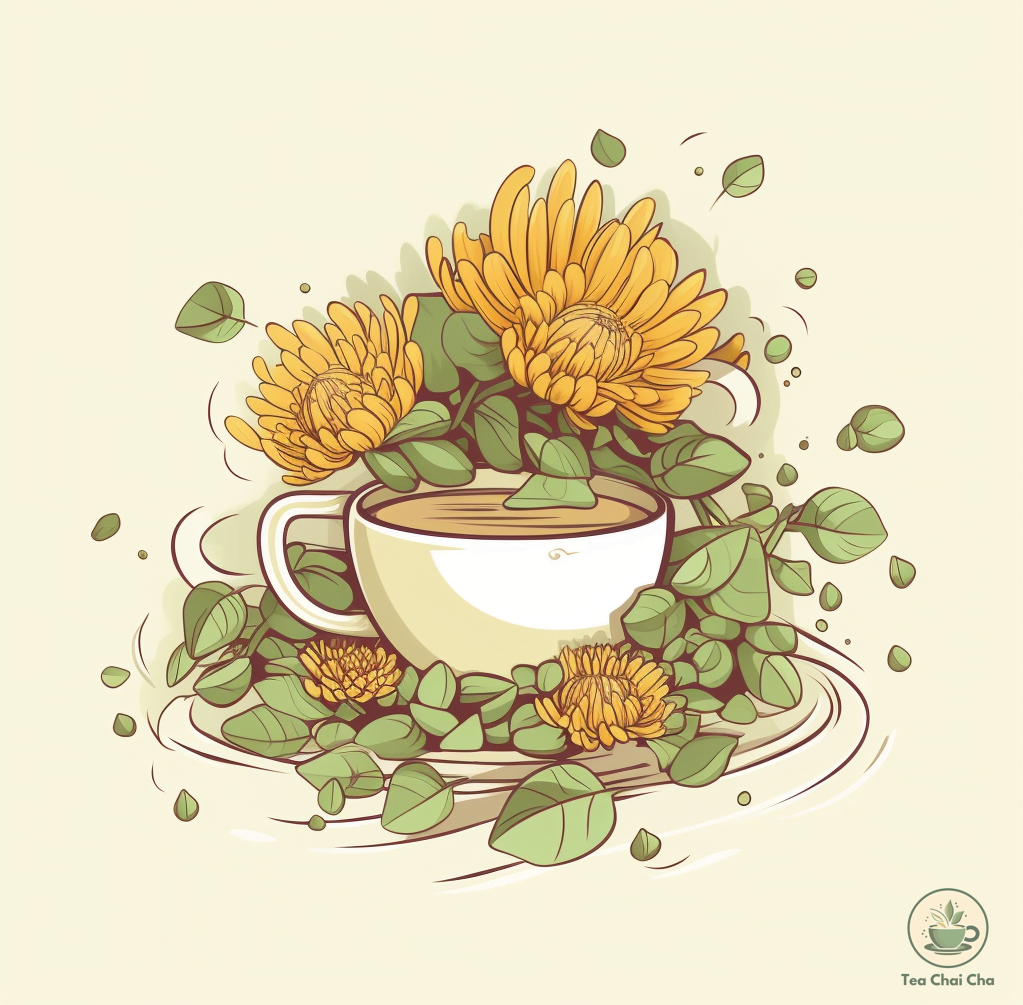
How to Make Chrysanthemum Tea Taste Better
When it comes to chrysanthemum tea, there are some simple tricks to elevate its flavor, turning a good cup into a great one.
Here are some tips that have worked wonders for me:
1. Choose Quality Chrysanthemums
It all starts with the chrysanthemum petals themselves.
Opt for high-quality, whole petals if possible.
These will give you a more robust and aromatic flavor as I mentioned earlier.
2. Adjust the Petal-to-Water Ratio
Finding the right balance is key.
Use about 2-3 grams or 1 to 2 teaspoons of chrysanthemum petals for every 8 ounces of water.
Adjust according to your taste – more petals for a stronger brew, fewer for a milder one.
3. Control the Steeping Time
Timing is everything. Steep the petals for around 3-5 minutes for a delicate, floral flavor.
Extend it to 7-10 minutes if you prefer a stronger, more herbal taste.
Experiment to find your perfect steeping time.
4. Optimal Water Temperature
Be mindful of the water temperature.
Use water that’s just below boiling, around 190-205°F (87-96°C).
Boiling water can make your tea bitter, and you definitely don’t want that.
5. Sweeten with Care
If you like a touch of sweetness, consider adding honey or rock sugar.
Start with a small amount and adjust to taste.
You don’t want to overpower the delicate chrysanthemum flavor.
6. Play with Citrus
A slice of lemon or orange can brighten up your chrysanthemum tea.
The citrusy zest complements the floral notes beautifully.
7. Experiment with Add-Ins
Get creative!
Try adding goji berries, wolfberries, or a sprig of mint for a unique twist.
These additions can introduce new dimensions to your tea’s taste.
8. Use Clean Water
Last but not least, use good-quality, clean water.
Tap water with strong mineral flavors can interfere with the delicate chrysanthemum taste.
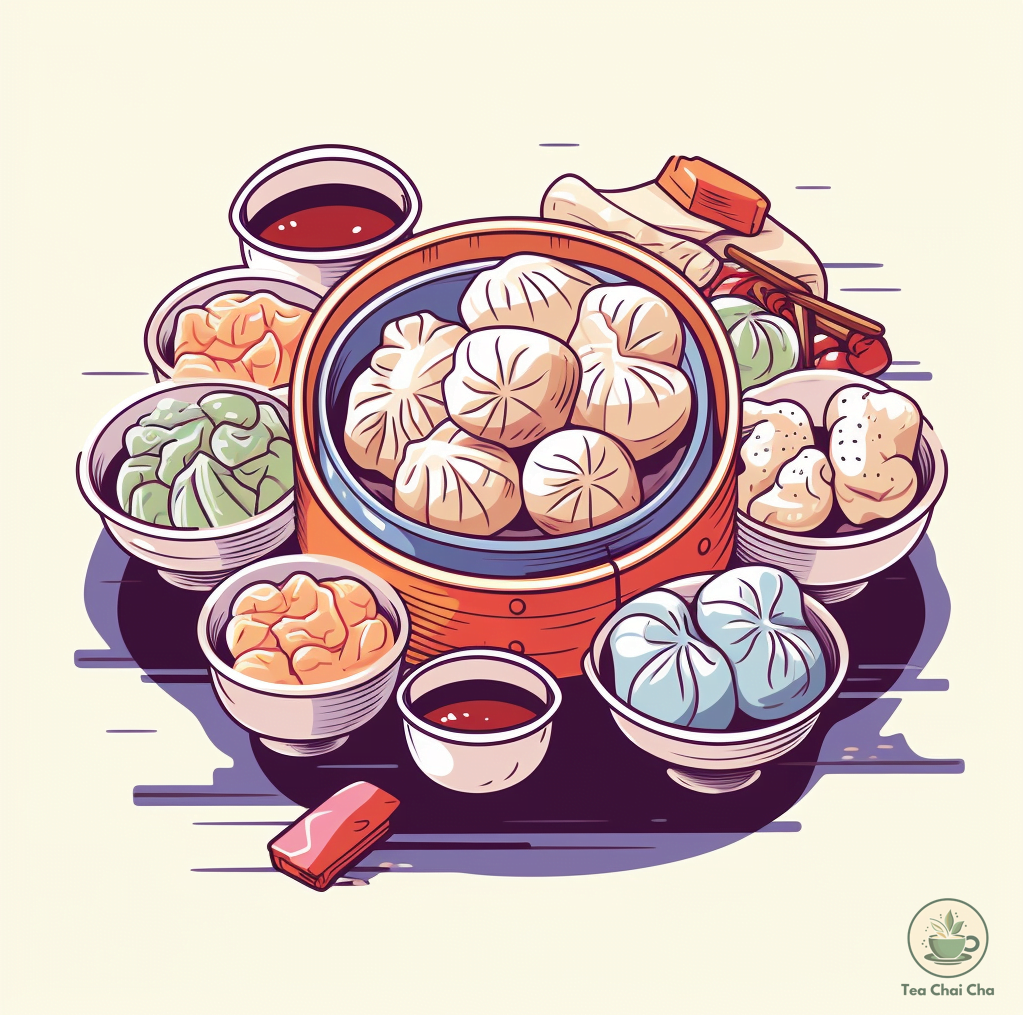
Chrysanthemum Tea Food Pairing
When it comes to enjoying chrysanthemum tea, it’s not just a solo act.
It often shares the stage with some delicious companions in Chinese and Asian cuisine.
Here’s a glimpse into how you can pair this fragrant tea with your favorite dishes.
1. Dim Sum Delights
Chrysanthemum tea is like the unsung hero at a dim sum feast.
Think of those delicate dumplings, fluffy buns, and savory spring rolls.
The floral notes of tea act as a palate cleanser, refreshing your taste buds between bites of these savory treats.
2. Spicy Saviors
When you’re indulging in spicy Sichuan or Thai dishes, chrysanthemum tea is your best friend.
Its gentle, cooling effect helps soothe the heat from those fiery peppers.
You’ll find yourself sipping it to balance the intensity of the spices.
Thus, making each bite even more enjoyable.
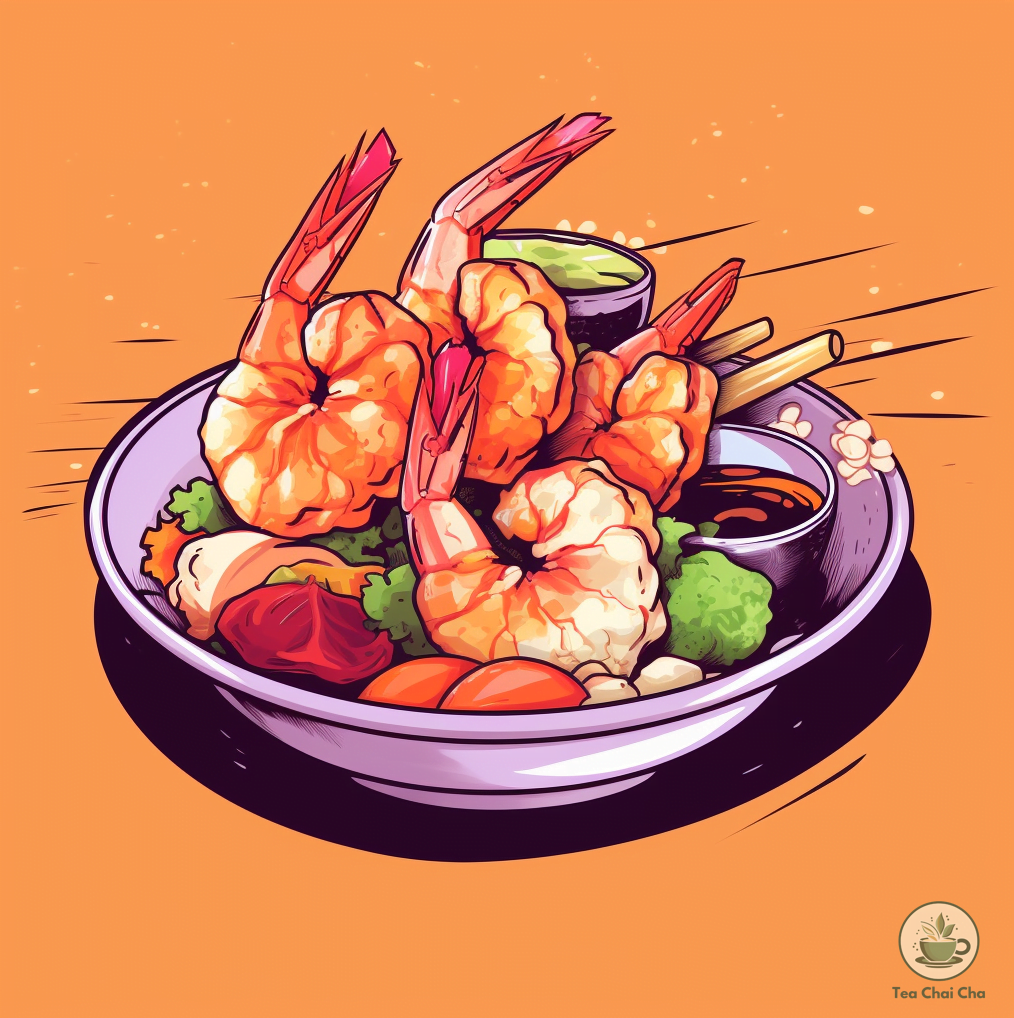
3. Seafood Serenade
Seafood lovers, take note!
Chrysanthemum tea pairs beautifully with seafood dishes.
The tea’s subtle floral aroma complements the delicate flavors of fish and shrimp.
4. Light and Healthy
For those days when you crave something light and healthy, a crisp salad or steamed vegetables with chrysanthemum tea is a match made in heaven.
The tea’s gentle, earthy tones bring out the freshness of the greens.
5. Sweet Endings
Chrysanthemum tea isn’t just for savory dishes; it’s also a lovely companion for desserts.
Perhaps, you are enjoying a piece of delicate, floral-infused cake or sweet rice dumplings with a warm cup of chrysanthemum tea.
The contrast of flavors elevates the sweetness, leaving a pleasant, lingering taste.
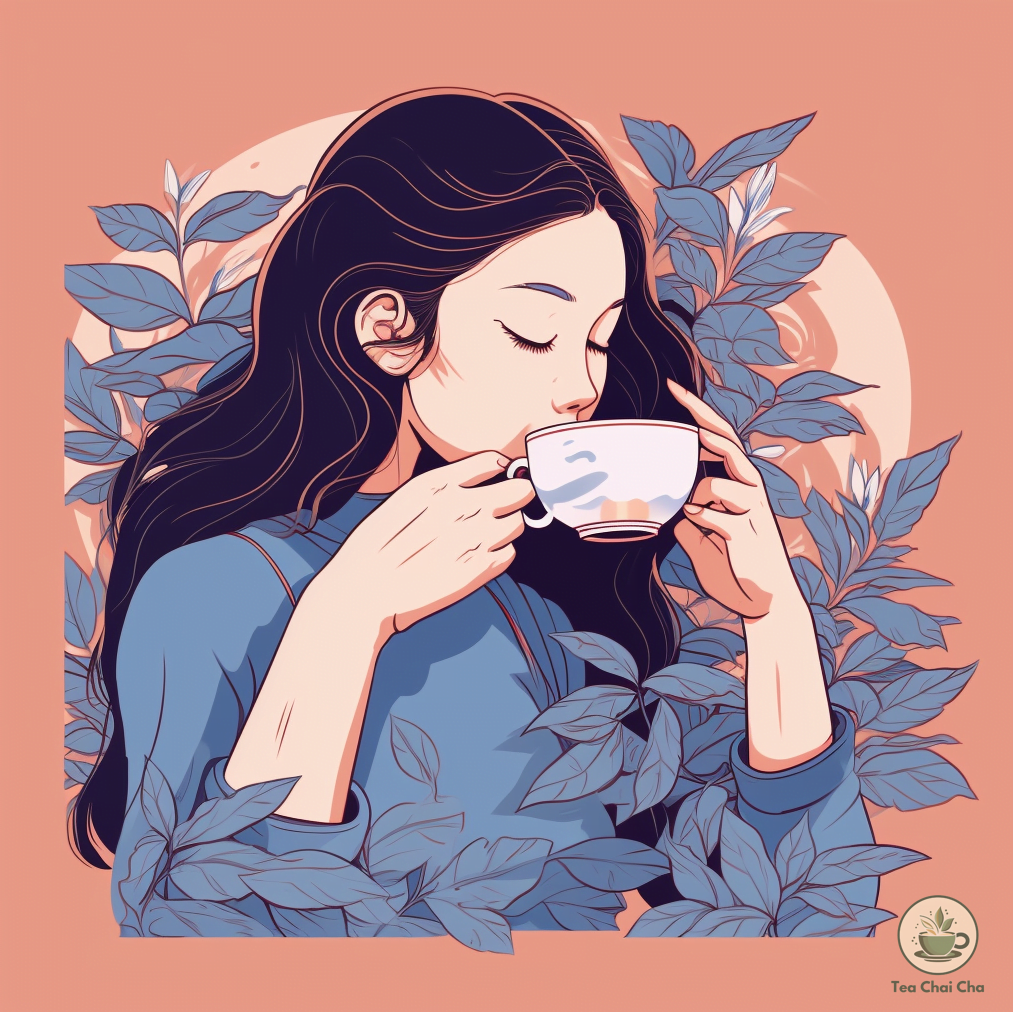
When to Drink Chrysanthemum Tea
Chrysanthemum tea isn’t just any ordinary beverage; it’s a delightful companion for various moments in life.
Here’s when I love to sip it:
After a Hearty Meal: One of my favorite times to enjoy chrysanthemum tea is right after a satisfying meal.
It helps with digestion and leaving you feeling refreshed.
Plus, it’s a healthier alternative to sugary post-meal drinks.
When You Need to Unwind: A long, tiring day, and you’re yearning for a moment of relaxation?
That’s when a warm cup of chrysanthemum tea comes to the rescue.
Its soothing aroma and calming properties make it an excellent choice for winding down before bedtime.
During Stressful Moments: When life gets a bit too hectic and stress creeps in, chrysanthemum tea can be your ally.
Its calming effect helps soothe frazzled nerves.
Hence, making it the perfect antidote for those anxiety-filled days.
On a Hot Summer Day: When the sun’s scorching and the heat feels unbearable, chrysanthemum tea shines as a refreshing, cooling drink.
Pour it over ice, and you’ve got a refreshing drink to combat the sweltering weather.
Festive Celebrations: In Chinese culture, chrysanthemum tea often graces the table during special occasions like the Mid-Autumn Festival.
It symbolizes unity and well-being, making it a must-have during these festivities.
When You’re Feeling Under the Weather: Chrysanthemum tea is also a go-to when you’re down with a cold or flu.
Its natural properties are believed to help alleviate symptoms and boost your immune system.
Related to Tea Making

Chrysanthemum Tea Recipe 菊花茶 (Júhuā chá, guk fa cha)
Recipe by Tania FaysalCourse: DrinksCuisine: Chinese2
servings3
minutes7
minutes5
kcal10
minutesBrew aromatic Chrysanthemum Tea, known as 菊花茶 (Júhuā chá) in Mandarin and guk fa cha in Cantonese, with this easy recipe.
Ingredients
2 tablespoons dried chrysanthemum flowers
4 cups of water
2 tablespoons of honey (or to taste)
Directions
- Boil the water: Bring 4 cups of water to a boil in a pot.
- Add the flowers: Once boiling, add 2 tablespoons of dried chrysanthemum flowers.
- Steep the tea: Reduce heat and let the flowers steep for about 7 minutes. The steeping temperature should be around 190-205°F (87-96°C).
- Strain the tea: Using a fine mesh sieve, strain the tea into a teapot or directly into teacups.
- Sweeten to taste: Add honey to taste, stirring until fully dissolved. Serve your chrysanthemum tea hot and enjoy!
Recipe Video
Notes
- Quality of Chrysanthemum Flowers: For the best flavor, choose high-quality dried chrysanthemum flowers. Look for petals that are whole and fragrant, free from any mold or discoloration. The better the quality, the more aromatic your tea will be.
- Floral Blend: Don't be afraid to experiment with blends. Chrysanthemum tea can be combined with other herbs or teas like green tea, jasmine, or even a slice of fresh ginger for added complexity.
- Water Temperature: Keep a close eye on the water temperature. The sweet spot is between 190-205°F (87-96°C). Too hot, and it might turn bitter; too cold, and it won't fully infuse the flavors.
- Storing Brewed Tea: If you have leftovers, chrysanthemum tea can be refrigerated for a day or two. It's lovely when served cold on a hot day. Make sure to store it in a sealed container to preserve its freshness.
- Presentation Matters: When serving chrysanthemum tea, consider using clear glass teacups. The beautiful golden hue of the tea and the floating chrysanthemum petals make for an elegant and visually appealing drink.
Frequently Asked Questions (FAQs)
What does chrysanthemum tea taste like?
Chrysanthemum tea has a unique and pleasant flavor. It’s floral and slightly sweet with a subtle herbal undertone.
The taste can vary slightly depending on the variety of chrysanthemum used and how it’s prepared, but generally, it’s light and refreshing.
Does chrysanthemum tea have caffeine?
No, chrysanthemum tea is naturally caffeine-free. So, it’s an excellent choice for those looking to enjoy a soothing beverage without the stimulating effects of caffeine.
Is chrysanthemum tea a real tea?
Chrysanthemum tea is not a true tea because it doesn’t come from the Camellia sinensis plant.
Chrysanthemum tea is an herbal infusion made from dried chrysanthemum flowers.
How many calories are in chrysanthemum tea?
Chrysanthemum tea is very low in calories. A typical cup of chrysanthemum tea contains only about 2-4 calories.
It’s a great choice if you’re looking for a refreshing drink without added sugars or significant calorie content.
How to make honey chrysanthemum tea?
To make honey chrysanthemum tea, you can follow the recipe above and add honey as a sweetener.
